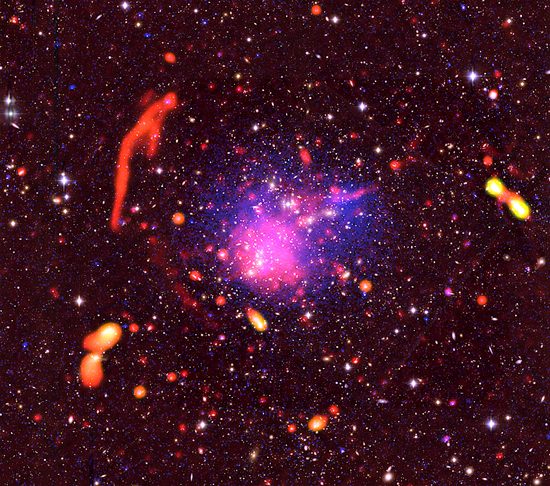
Composite image of Abell 2744, with combined radio, X-Ray, and optical images. Credit: Pearce et al.; Bill Saxton, NRAO/AUI/NSF; Chandra, Subaru; ESO.
Aug 20, 2018
Gas and dust in space are not heated by gravity.
Picture of the Day articles note that astronomers persistently identify electromagnetic formations as gravitationally induced phenomena. For example, particles surging out from stars like the Sun are called a “wind”, instead of electric charge flow. Streams of ions accelerated by magnetic fields are called “jets”, instead of collimated beams of electricity; while changes in the density and speed of charged particles are almost always referred to as “shock waves”, and not double layers that can store and dissipate electricity.
Since astronomers have only one force in their bags of tricks—gravity—high temperatures in some structures, like galaxy clusters, are an enigma. Electric charge is sometimes brought up, but it is usually considered to be a negligible force.
Little knowledge about electricity in space accounts for their opinion that gases “crashing into each other” produce X-rays and other energetic emissions. Since perception is reality, without exposure to theories about electricity flowing through plasma no perception of it can exist in the mind’s eye.
In the image at the top of the page, Cluster Abell 2744 is said to represent the collision of several galaxy clusters, each with dozens, or even hundreds of galaxies. The material inside some clusters is “crashing into” material from others, heating the gas and dust until it glows in X-rays.
Astronomers think that plasma is simply ionized gas that behaves like neutral gas, for the most part. They cannot measure the properties of extragalactic space, directly, so they develop mathematical models based on the behavior of neutral gases. Hannes Alfvén took a different approach. In his monograph, Cosmic Plasma, he described how theory has lost touch with reality. Rather than theorize about plasma, he studied its properties in the laboratory.
In the consensus view, Abell 2744 is thought to be hot because the molecules of gas and dust crashed into each other, resulting in X-rays flashing out from the blue color-coded regions. It is not surprising, therefore, that observations appear to match the simulations. The ideas used to build computer algorithms are also in the minds of those working with the instruments. Building a device that is designed to see what has been simulated is how modern science works. Carts and horses come to mind.
As Hannes Alfvén wrote:
“The cosmical plasma physics of today…is to some extent the playground of theoreticians who have never seen a plasma in a laboratory…several of the basic concepts on which theories of cosmical plasmas are founded are not applicable to the condition prevailing in the cosmos.”
Stephen Smith












